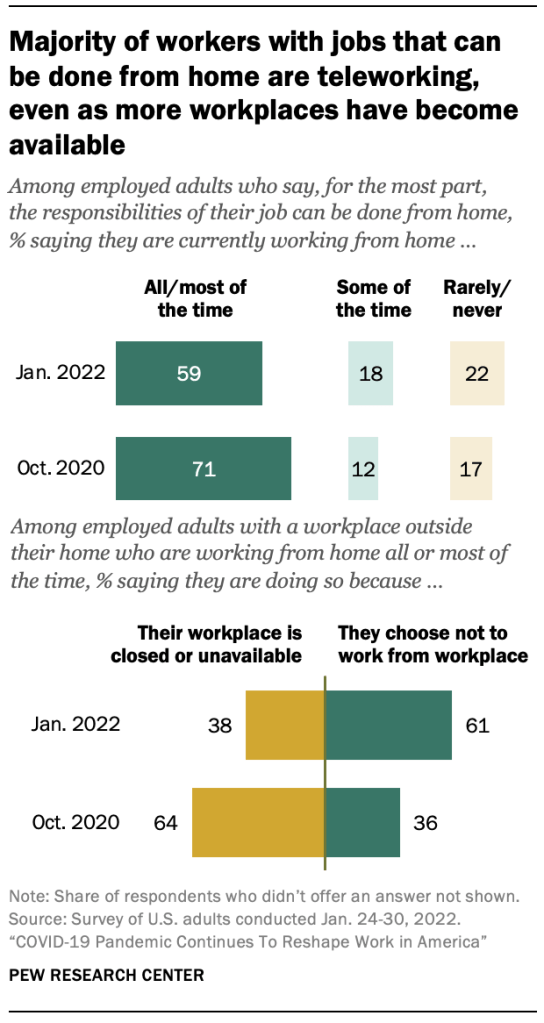The War Over the Workplace: Workers Want Flexibility, so Why Are We Fighting It?
Add bookmark
Where we work matters.
I don’t think anyone would argue with that, really. But just as important as where we work is who chooses where we work (and why), and that’s where we get some contention on the issue.
During the pandemic, a huge portion of the workforce was working from home, with about half of the population likely working from home at least some of the time. There’s some disagreement about this number, largely caused by the Current Population Survey (CPS) concluding different results than many other surveys, including other government surveys and ones conducted by private research organizations like Gallup. This discrepancy has been used to argue that WFH was not as prevalent as public perception, but the Stanford Digital Economy Lab published a paper (“How many Americans Work Remotely?”) that explained how survey methodology can lead to outlier responses.
If you take into account people who are self-employed, people who were also working remotely before the pandemic, and people who only work remotely sometimes, people who had an opportunity to work remotely during the pandemic represent a significant portion of the workforce (the survey from this Stanford research paper represented in the table below was conducted in October 2022).

When Workers Taste Flexibility, They Like It
In the State of Work & Career Success 2023, we found that 64% of U.S. workers agree that ‘I work best when I can work anywhere I want’ and 62% agree that ‘I work best when I can work when I want.’ We also see more people indicating that the job they are in is a better fit than a year ago, which is likely related to reporting greater workplace flexibility than a year prior.
Additionally, Pew published some revealing research about this near the end of 2022: “Among those who have a workplace outside of their home, 61% now say they are choosing not to go into their workplace, while 38% say they’re working from home because their workplace is closed or unavailable to them. Earlier in the pandemic, just the opposite was true: 64% said they were working from home because their office was closed, and 36% said they were choosing to work from home. “
Some leaders are ‘blaming the need for mentorship’ to rationalize returning to the office, but our survey indicates that mentorship opportunities are almost non-existent in U.S. workplaces. So, unless they’re going to go through a much more dramatic organizational transformation than embracing hybrid work, that feels like a poor excuse. More believable is that leaders believe in-office work is important to company culture, and that is a common perception among workers, although that is not necessarily a shared priority among workers.
The eLearning Industry Future of Work Study found that “two in five (44%) employees say their leaders need to be more in touch with how they prefer to work, and one in three say their employer doesn't provide the right work environment for them.” In The State of Work & Career Success study, we found only 39% of respondents report working in a ‘flexible environment.’
Flexibility ≠ Working From Home
A recent study from Hassell found that workers who were forced back into the office were twice as likely to quit (19% vs 9%). Interestingly, people who were forced to work full-time from home were also more likely to quit, up to 13%. Again, who chooses where we work and why we choose where we work matters a great deal.
It’s critical to acknowledge that this isn’t specifically about working from home, although that is possibly the biggest battle that will be fought in the war over the workplace. People want flexibility. Period.
Our survey shows that two-thirds of workers think ‘my work should accommodate the way I want to live my life.’ MetLife’s 2022 annual study of workplace benefits similarly shows an overall rise in employee expectations of their employers, but especially when it comes to a flexible workplace.

Yet, despite a general consensus that people like having choices, we are again seeing an aggressive push to bring workers back into offices in recent weeks. It is impossible to argue in good faith that this is to help workers — and if we’re not doing our best to make work a place where workers can do and feel their best, then it’s going to be hard to expect having the best people or getting the best out of them.




























